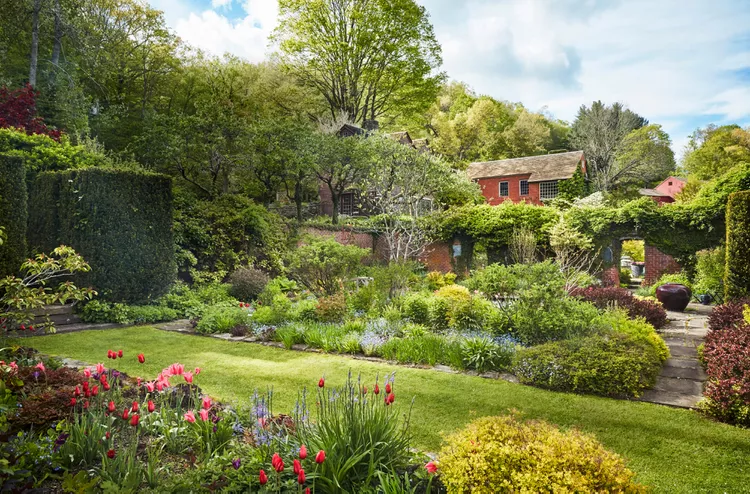Over the last several decades, Hollister House in Connecticut has become one of the most inspiring gardens in America. Influenced by famous English gardens, owner George Schoellkopf turned his own property into a series of architectural rooms filled with lavishly romantic plantings. The contrast between formality and wildness, a cornerstone of English gardens, has made Hollister House an icon in its own right. And yet its garden design ideas can translate—and bring magic—to yards of any size.
George Schoellkopf
My garden is my way of making art, but it's never the same from year to year. Plants grow; plants die. I am always repainting the picture.
Design Around Stairways
A stairway can be transformed into a design feature instead of something that merely gets you from one level to the next. At Hollister House, steps made of local granite slabs are placed randomly and softened by yellow-leaved dwarf spirea and violets that have seeded in the cracks.
Add Life with Water Features
This rectangular pool in Hollister House’s walled garden makes a gentle ripple with its recirculating pipe, creating a soft sound that adds to the sense of calm. Even the smallest water feature—a bowl or trough—will bring tranquility to a garden, reflecting the sky and inviting birds and dragonflies.
Repeat Plants
Repetition is a garden design idea the pros use often, as it pleases the eye and draws you through a space. Here, the chartreuse color of dwarf spirea down the stone steps is echoed in the shrub by the wall and in the yellow tulips. Chartreuse (also think lady’s mantle or creeping Jenny) is one of the best colors for lightening a planting scheme.
Allow Plants to Self-Seed
The granite steps, brick path, clipped boxwood, and apple and crabapple trees provide structure, while the forget-me-nots that have seeded at the edges of the path bring a sense of spontaneity. If you plant one forget-me-not or toss some of its seeds in your garden, you will have its haze of sky blue in unexpected places in a year or so—the sort of occurrence that gives a garden charm.
Create Stopping Points with Pots
Placing a decorative pot on an axis stops the eye for a moment in a delightful way. This is an often-repeated design element at Sissinghurst as well as at Hollister House. A patinaed kettle filled with pansies, below, asks you to step around before continuing through the archway. Having spaces in a garden divided by walls or hedges—so you catch only a glimpse into one from another through an opening—urges you on with a sense of surprise.
Pay Attention to Paths
At Hollister House, garden paths are the geometric threads that lure you through the various lavishly planted spaces. Where the old house meets the brick barn structure, opposite, forget-me-nots, lady’s mantle, lungwort, daffodils, and tulips take the edge off a stone path. For cohesion, George has limited his colors to yellow with a splash of white and blue.
Create Geometry with Hedges
A series of beds planted with white tulips and edged with tidily trimmed boxwoods create a formal arrangement known as a parterre; it’s particularly appealing when seen from above. It's a garden design idea you can apply on any scale: Try four small square beds edged with lightly clipped germander or a thick border of thyme or parsley as a frame around something special like a rosebush or tall flowering alliums. Deep burgundy accents are repeated in the central urn and in Japanese maples just beyond the garden.
Visit Hollister House
Although Hollister House is a private residence, the garden is open to visitors several days a week during spring. Check the website for the current calendar.




















